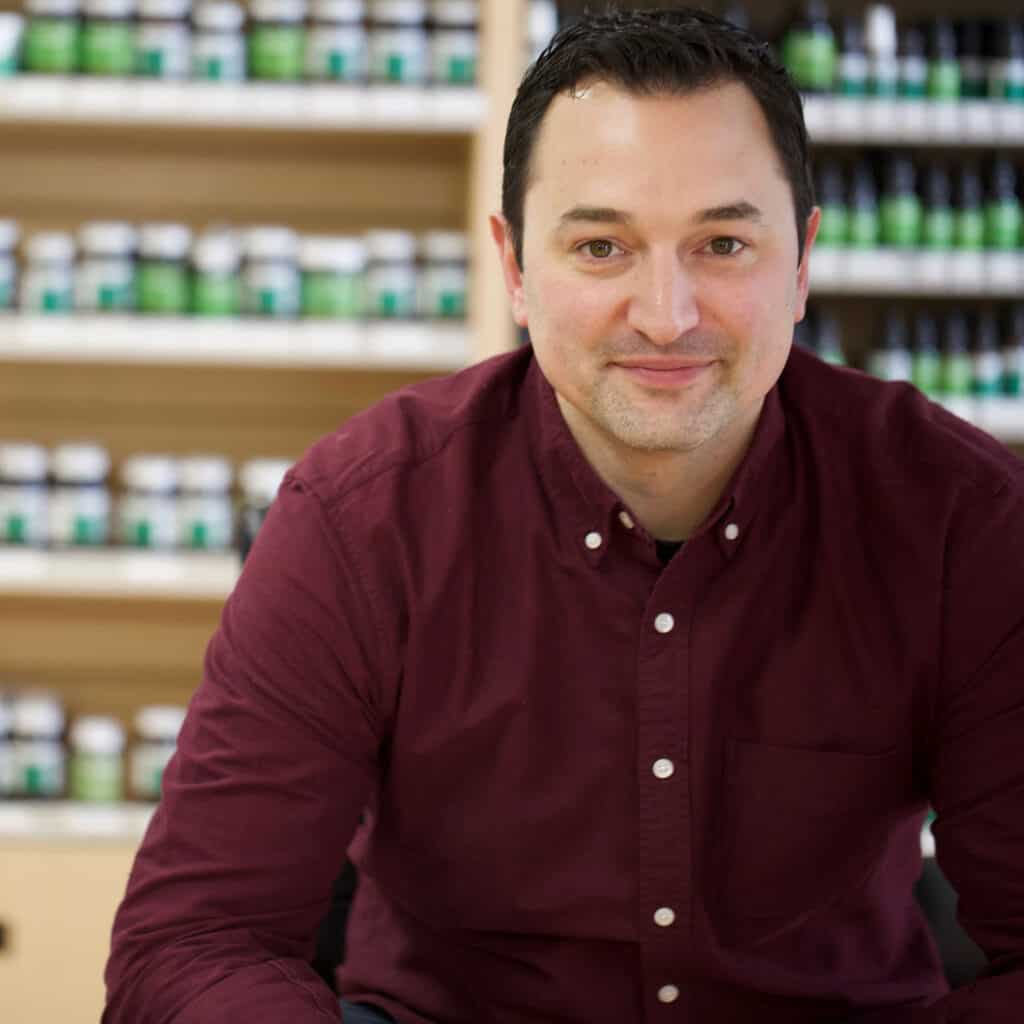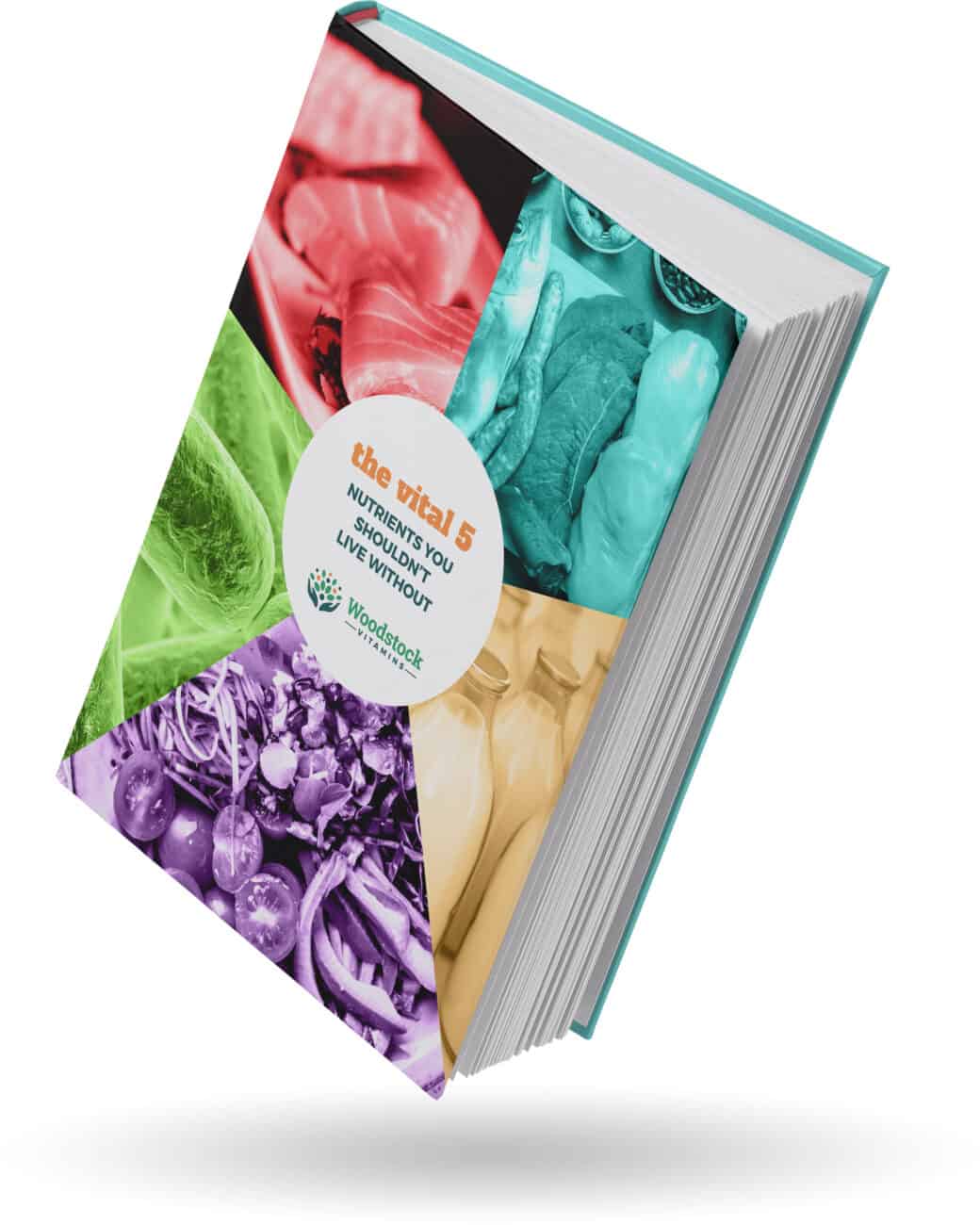In the news this week: “Eggs are bad and if you eat them you’re a jerk.”
Then comes the blog articles from all the food babes and company: “THEY say eggs are bad but we’re smarter than scientists so we disagree,” or “See, we told you eggs were bad duuuuuhhhhh.”
Fair and balanced reporting, America style.
I’m kinda tired of all of this. “Good.” “Bad.” “President.” Labels applied to things that aren’t real and are pretty much meaningless.
I get it, I do. We apply labels as a mental shortcut to deal with information overload. I’m guilty of using them in my articles and teachings, too.
I think this study makes me want to change my ways, and I think we change together. The picture is too nuanced.
Let’s talk about all fats. The “good,” the “bad,” and the ugly. I’m going to teach you a strategy for persevering through the (seeming) yo-yo of nutritional science.
I’ll point out which fats definitely deserve the name calling. More importantly, I’m going to don my tin foil hat, citing reasons why I think we are quick to apply the G or B word to fats.
It’s time to chew the fat.
What Came First: Misinformation Or The Egg?
I’m not 40 yet and I think eggs have fallen in and out of favor at least 7 times since I’ve learned my colors. So like every 5 years. It’s insanity.
JAMA posted a large observational study that showed a relationship between egg intake and heart disease. If you eat 2 eggs daily (14 weekly for those without a calculator handy), you will have almost a 30% increased risk of heart disease. Each additional half egg consumed daily was tied to an even higher risk of something bad – heart attack, stroke, not using your turn signal, etc.
It’s a big study over a long period of time, and generally, the methods were good, so some people are giving the study some street cred. As with any nutritional study, though, there were some flaws. Like where they only asked people about their diet once. Kind of a big deal, no? There’s more, but I’m not here to beat that one study up. I want to beat up all of them.
The biggest flaw was not the study, but the scientific media taking this football and running it in for a misinformation touchdown. This study wasn’t really about eggs! Eggs were used as a marker for dietary cholesterol intake, of which eggs are high in cholesterol. They’re also high in healthy fats and protein, but no mention of that. We have lots of studies showing eating an average of 1 egg daily is NOT associated with increased heart disease risk. No mention of that in the articles about it.
But, the clickbait headlines write themselves, and this adds more wishy to the wishy-washy nature of our discussion around nutrition.
It’s not like eggs live in some sort of dietary vacuum, and all other decisions we make are unrelated. That’s what the media lead many people to believe. “You have health issues. It wasn’t you. It was the eggs!”
To do a proper dietary study where we could point at eggs being “bad,” you’d have to find LOTS of people who do similar things with their WHOLE diet (and lifestyle) and then compare the different egg intakes. Near impossible, especially at the timeline needed. I can’t even stick to consistent eating two weeks at a time, let alone 10 years. Not realistic. No mention of any of this in any of the articles most people clicked on.
You know what else wasn’t mentioned? The 200 different variables to the eggs themselves. Free range or grain fed? That would dictate the fat makeup of the egg itself. Fried or scrambled? Extra oil added while cooking or not? You see what I’m getting at.
The nutritional picture here is murky at best and all articles generated from studies like this is add to the confusion. People will push away eggs – a healthy option for a great breakfast for most of us – and probably make worse meal choices, not better ones. “Eggs are out so I’m going to eat Lucky Charms. They’re fortified with vitamins.”
EGGS WILL NOT KILL YOU. Unless you try to swallow an uncracked one whole. You know what will hasten death? Eating too much unhealthy stuff and making lots of unhealthy choices over a long period of time.
The study was trying to get at something we really could use some clarity around: what is the amount of dietary cholesterol intake that increases our risk of heart disease? I want to know this answer, but I’ll say this to myself (and to you) again… high cholesterol doesn’t exist in a vacuum. What does the whole picture look like? Along with high cholesterol foods, are you making other horrible decisions?How do we identify what that high cholesterol is doing to you, and when, and can we manage it?
The study and media could have as easily blamed shrimp intake, as the cholesterol levels per serving are about the same as eggs.
Nutrition science is getting more refined. We don’t believe there’s a direct connection between moderate cholesterol consumption (300mg or more) and unhealthy blood cholesterol (LDL, etc). The US dietary guidelines no longer include cholesterol limits, and instead put most of the heart-health blame on sugars and “bad” fats, which we’ll identify.
Ok, I’m calm now. Wait, no I’m not. This is the problem with research being reported on in the media! The wrong message gets blasted out there, then it’s on us (the responsible) to spend the rest of the year/our careers refuting it.
Because the data changes so frequently and because it is so difficult to nail down what’s real and what’s not, we shouldn’t allow every study that gets published to knock us off balance.
If you go down the rabbit hole of research, you’ll see conflicting bits of data and at times, controversy. Especially around fats. This leads to confusion and analysis paralysis. We don’t have time to get the story 100% straight. We need to act now by making the healthiest choices we know of. Right now. We need to see the forest for the trees.
Our approach for this article and for all our nutritional recommendations is less about micromanaging dietary choices to match the newest, shiniest data, and more about finding reasonable middle ground for a generally healthier life in a more sustainable manner.
Here’s how you stay on track and ignore the yo-yo: know what you’re talking about. I’m not putting consumers down, but this is the reality. The reason we are so susceptible to the propaganda around nutrition is because we aren’t studied enough. Many of us can’t define what makes foods healthy or unhealthy. We just go with the labels “they” tell us. Stick with me, and I’ll teach you to have a BS meter like mine!
Here’s 4 steps to help in your journey:
- Know most casual information out there (stuff you find on google) is a gross exaggeration at best, lies at worst.
- Don’t stop at face value. “Eggs are bad.” Ask more questions so you thoroughly understand the question.
- Begin again on your nutrition education. I suggest you re-read our Eat To Fuel Your Fire article to redefine what makes foods healthy at the “white belt” level of understanding.
- Know that foods, like us humans, are imperfect. They will all have a bit of the devil in them. There are very few actual demons – the truly harmful compounds that must be avoided. Instead, there are compounds we should minimize, some we should get more of, and some we should eat every day.
That last point I hope to stress a bunch in this rant. There’s one graphic I share that will help destroy the “good” and “bad” labels for you as they currently are applied. Who’s ready for some fat chat?
Fats 101
Fats are one of the 3 macronutrients our body uses for energy and other body processes. We’ve talked extensively about specific fats, like in our omega-3 articles (here and here) and our recent Keto Rant aka bacon will help me lose weight.
We’ve touched on cholesterol, a type of fat compound found in cell membranes of all animal cells and used by animals to make hormones. You may have heard lots of different types of fats like MCT, saturated, unsaturated, Fat Albert, omega-3, omega-6, and Fats Domino. We’ll geek out about most of those today to help you get your head around different fats once and for all.
With Fats, Size Matters
To keep these things straight, we have to get organized. It’s best to read the next two sections while listening to Fleetwood Mac’s “The Chain.”
One way fats are categorized are by the sizes of their, um, tails. Fats are long chains of carbon molecules. There are short chain fatty acids (5 carbons or less), medium chain fatty acids (6 to 12 carbons), and long chain fatty acids (13 and more carbons).
The length of the chain dictates how and where the fat will be used in the body. Short-chain fatty acids are not eaten, but instead are made by the bacteria in our gut. The normal flora ferment carbohydrates – dietary fibers – and one of the waste products is SCFAs. Yes, you read that right: fibers are turned to fat in the gut. The SCFAs are used in numerous body systems, but primarily SCFAs are a fuel source for the cells lining the gut. Another reason why we tell people fiber is so important – to keep the lining of the gut healthy by making and using the SCFAs!
Medium-chain fatty acids form up and make Medium-chain triglycerides (MCT) which is the new cool thing to eat, as we discussed in our Keto Rant. Really what MCT is, in my opinion, is precut, seasoned and dried firewood. It’s fuel that’s ready to go. It takes very little effort for our body to absorb and utilize the energy from MCT. If people have malabsorption, using MCT oils can help get fuel into the bloodstream quickly. With the rising popularity of the Keto diet, MCTs have been used as a primary fuel source. Coconut oil is well known for it’s MCT content.
Long-chain fatty acids are the more common fats we ingest. Omega-3 and Omega-6 are long-chain fatty acids. What’s interesting about these compounds is that they aren’t absorbed directly into the bloodstream like other fatty acids can be. Instead, they’re taken up by the lining of the gut and turned into these “fat energy bombs” called chylomicrons. These are dumped out in larger veins near the heart (smart since they are so big – don’t want to clog up traffic!) and used as energy sources or stored for later use.
Organizing Fats By Their Kinks
The other way to talk about fats is to talk about their chemical structure. We’ve said fats are chains that vary in size. They are chains of carbon atoms. If you know anything about carbon from chemistry class, you know that it has 4 spots where it can create a bond with other compounds. Since it’s making a chain, two of those spots are used to make the chain (black), but 2 are free to do something else (orange):
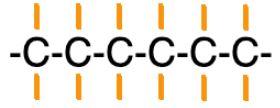
There are two things this carbon will do with those orange lines. It can hold a hydrogen molecule or it can double up the chain connection, strengthening it. This seems boring, but there is a very good reason I’m telling you all this. Let’s look at an example chain that is holding as many hydrogen as possible:
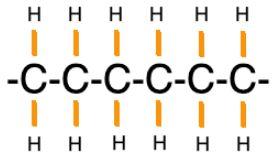
When a carbon chain (a fat molecule) holds as many hydrogens as possible, it is said to be saturated with hydrogen. A saturated fat is a fat molecule that is saturated with hydrogen on the chain. The result is a super straight structure.
Now look at what happens when our fat molecule is unsaturated:

Unsaturated fats have a kink in the chain, making them more bendy and generally wired.
Let’s pretend for a moment that every cell in our bodies is made up of fat molecules (‘cause they are). What would a cell membrane look like it if were all saturated fats or only some saturated fats and mostly unsaturated fats? I’ll show you:
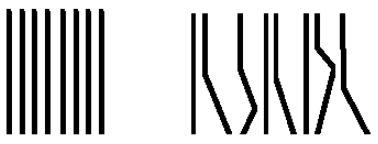
Saturated fats are on the left, while a mix is on the right. They’re spaced the same distance apart, but because of the bendy nature of unsaturated fats, the membrane becomes more spaced out (like many of you reading at this point?). One of the proposed mechanism of saturated fat contributing to heart disease is that cells become more rigid and less flexible, allowing for hardening and plaquing of the vessels due to blood flow issues.
I say all that to say this. Saturated fats are “bad” because they are rigid. Unsaturated fats are “good” because they are bendy.
Saturated fats are a part of our body system, but too much saturated fat can cause cell membranes to be more rigid. This makes hardening of the arteries MUCH easier. It’s better, in general, to consume less saturated fats than unsaturated fats.
That’s the science. You now know why saturated fats and unsaturated fats have that name. On top of this, we know why saturated fats are less healthy.
Let’s talk about fat types practically.
Saturated Fats
Saturated fats are generally regarded as “bad.”
Saturated fats are found in many animal products like meat or dairy. And eggs. Don’t forget them.
Butter is the most known saturated fat weighing in at 64%. If you’re nervous about that, let me introduce you this HEALTHY alternative, coconut butter/oil. Oh, coconut butter has 90% saturated fats? Sorry, I forgot to mention it…
Cashews have about 20% saturated fats.
Common saturated fats are lauric acid, myristic acid, palmitic acid, butyric acid, or stearic acid. You’ve probably never heard of them, but there they are.
High saturated fats seem to lead to Type II diabetes as well as an increase in LDL cholesterol. Diets high in saturated fat lead directly to hardening of the arteries and heart disease, so it is advised to minimize them.
Unsaturated Fats
The bendy unsaturated fats are generally considered “good,” but that doesn’t paint a total picture. Their effects on the body are generally beneficial, but the specifics for each fat vary widely. We’ll discuss why.
Chemically, unsaturated fats can have a single bend or they can have a bunch.
Unsaturated fats, because of their bends, are at high risk of oxidation aka going rancid. Antioxidant compounds, whether natural or synthetic, can reduce oxidation of unsaturated fats.
Let’s look at the two different types of unsaturated fats, monounsaturated and polyunsaturated.
Monounsaturated
Monounsaturated fats have a single bend. They tend to be long (or very long) chained fatty acids. The most common one you may have heard of is oleic acid, from olive oil. Olive oil is 75% monounsaturated fats.
Animal flesh, dairy, high-fat fruits like avocados, macadamia nuts, sesame oil, popcorn, whole grain wheat, almond oil, and sunflower oil all contain monounsaturated fats.
Polyunsaturated
Polyunsaturated fats have 2 or more double bonds, meaning 2 or more bends in the structure. When we think of polyunsaturated fats, we should generally think about the omega-3 and omega-6 fatty acids.
You have heard me bang this drum a bit: we get too much omega-6 from our diets and we need to increase our omega-3 intake. I’ve stated vaguely that omega-6 tends to be more inflammatory than omega-3. I tackled inflammation – and this specific mechanism – in the podcast episode Inflammation: The Silent Killer.
Omega-6 fats are linoleic acid (LA) and gamma-linoleic acid (GLA), along with a few others you’ve probably never heard of.
Omega-3’s are alpha-linolenic acid (ALA), which is a precursor to the big ones, EPA and DHA.
Although unsaturated fats are “good,” the amount of omega-6 or ratio of omega-6 to omega-3 is the real determinant if an unsaturated fat is healthy. Most foods rich in omega fatty acids will have higher amounts of omega-6 to omega-3. The “healthiest” omega-rich foods will have more omega-3 or at least a 1:1 ratio of 6 to 3. Though a food may have lots of omega-3, it may be ALA, which is VERY weakly converted to EPA and DHA. This is the reason we still encourage the omega-3’s EPA and DHA as a Vital 5 nutrient.

We’re starting to add dimension to this discussion. Olive oil, rich in monounsaturated fats, also has polyunsaturated fats that are predominantly omega-6, which can be pro-inflammatory and “unhealthy.”
There are other unsaturated fats that are very much unhealthy, and they deserve their own section.
Enter Trans Fats
In our desire to lower costs and bump up the profits, we created a monster. Feeding millions and millions is expensive, especially if fats can go rancid or are difficult to store as they are liquids. We synthetically modified vegetable oils by pumping them with extra hydrogen molecules. This partial hydrogenation created Franken-fat, trans fats.
Trans-fats are unsaturated fats that simply have their hydrogen molecules on opposite sides of the kinks. Yes, trans-fats are unsaturated fats, and this is why it is improper to refer to groups of fats as “good” or “bad.”
Trans fats are less food and more plastic. These are the hydrogenated oils that make our artificial butters and gross vegetable oils like Crisco.
The health impact of unsaturated (or even saturated fats) can be seen as controversial. “In this study numbers went down.” “In this studies numbers went up.” It is not so for trans fats. There is consensus that trans fats provide no health benefit for humans that would offset the negative. Trans fats will raise LDL (bad cholesterol) and lower HDL (good cholesterol). It’s empty calories in the fat world.
It is better to use real butter than margarine or Crisco. It’s not the best, but it is less worse.
The World Health Organization has tried to implement a goal to remove trans-fats from the food supply by 2023.
But let’s be honest! Trans fats exist in nature, so you’ll always get SOME exposure. Oh yeah, products with less than 0.5g of trans fat per serving can be labelled as no trans fat. Eat real foods, not packaged or processed stuff.
Let’s Simplify It, Then Re-Complicate it
“Ok Neal, I get it. We want to completely avoid trans fats. We want to minimize saturated fats. We want unsaturated fats, especially monounsaturated fats and polyunsaturated that are rich in omega-3.”
Like meditation, it’s simple but not easy. The statement above is generally great advice and is probably what places like Mayo Clinic would say, but let’s go even deeper.
Foods don’t contain one type of fat. I’m including an edited version of a graphic from Wiki to show this.
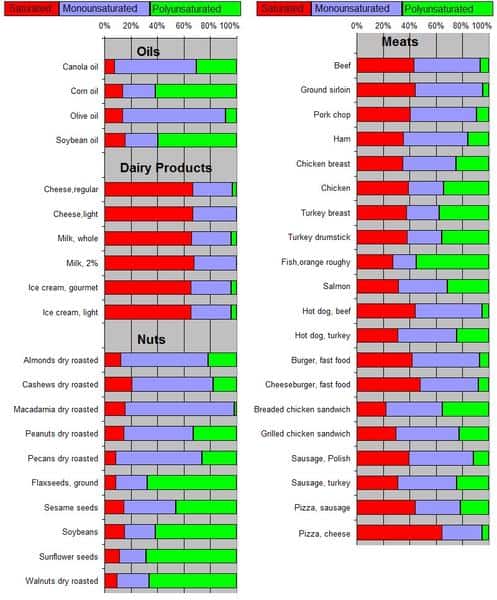
‘Healthy’ foods have unhealthy amounts of ‘unhealthy fats.’ If this chart had Omega-3 & 6 content, it would give us a good sense of what’s what.
Looking at this, you can pick out a few healthier looking fats. Flax looks great, if we hadn’t beaten that up before. Canola oil looks great too! Not really.
We’ll talk about one more factor to consider to finally identify what fats are healthiest.
Second, while oils pressed from foods may be the healthy options on this chart, the reality is that some of these compounds are not made for commercial use this way.
The Final Fat Frontier
Home stretch everyone.
If you were to squeeze a canola plant (different from a cannoli, fyi) and make your own canola oil, you’d have yourself a pretty healthy fat source.
But, that’s not how things go in the world. Most oils obtained from healthy vegetables and nuts are commercially made in the most unnatural way, and as a result, you are getting something minimally nutritious with some level of synthetic chemicals.
I’ll use canola oil as an example for most commercial vegetable oils, which are sometimes referred to as RBD oils. Refined. Bleached. Deodorized. How healthy does that sound?
For canola oil, 90% of it or more are GMO crops. Not a problem itself, but it should be known. To get the oil out, it isn’t pressed, but extracted with hexane. A potential carcinogen. The canola oil is then hydrogenated, making a trans-fat nightmare that is also rich in Omega-6. Because it oxidizes, BHT and BHA are often used as antioxidants to prevent spoilage.
My poor wife read this and said, “Oh no, I just bought organic canola oil.” I said, “Yep, that just means it’s a chemical soup with less pesticides and herbicides.”
This goes for things like soy, corn, palm, and even olive oil. Yes, healthy olive oil. This is why you want extra virgin olive oil from brands like California Ranch, as they do not do these unnatural processing methods nor do they dilute the final product with cheaper vegetable oils.
We haven’t even touched on some of the estrogenic compounds found in some vegetable oils like soybean and flax!
Unless you are cold pressing the following yourself for short term use, the following vegetable oils should be avoided.
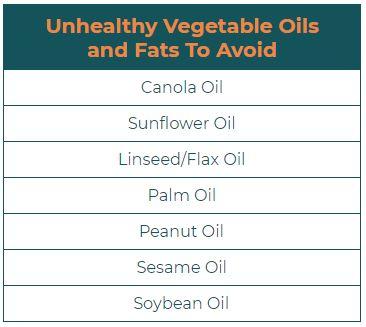
The Guide To Fats
Here’s how you should look at fats:
- There is no safe level of trans fat, so none at all.
- Avoid processed vegetable oils, fats with high omega-6, processed w/solvents, things with artificial antioxidants. These aren’t really foods.
- Eat unsaturated fat-rich foods, but make sure they have increased concentrations of Omega-3 and decreased concentrations of Omega-6

These guidelines are fine, but we need a varied diet. You can and should eat other healthy fats, even if they are not the perfect fats. It’s ok to eat butter. Coconut oil has more sat fat than butter. Just be responsible.
Here are your intake guidelines, for completeness sake:
- All fats should account for less than 25% of your calories.
- This is why in our campfire analogies or our simple diet fix we put fat at ¼ of the plate.
- In a typical 2000 Calorie diet, 500 calories should be fat (about 55g),
- Saturated fat should be less than 10% of your calories. But shoot for as little as possible.
- 100 calories from saturated fat (22g)
- In real terms, 22g saturated fat is 3 oz dark chocolate, 3 tablespoons butter, 1.5ish tablespoons coconut butter.
The best choices are the ones commonly mentioned, but now you know why. If we were to award a prize for best fats, they would be given to olive oil, avocados, and fish. And each of these have their own baggage, circling us back to the beginning. Bad and good are stupid labels to apply to foods.
Bashing Fats Is Phat
(Phat is a 90s word that means cool)
It seems there is an almost trendy nature to putting down fats. It’s fashionable. “Toxic.” “Worse than sugar.” Linking it to death or disease inappropriately. All things people are doing. Except when they tell you coconut oil is so healthy and you should replace all fats with it. Almost like you shouldn’t hop on trends.
The repetitive, hammering theme here is to not fall into the label game with a less than basic understanding of nutrition. When we understand that all fats have bad traits and what we should be concerned with is the degree to which a fat is bad, we can take a step back and ask a tougher question: why do we have such a disdain for some foods and macronutrients?
Here’s what I think: the public discourse around fats (and health) is primarily political propaganda with economic motivations.
Grain or wheat subsidies lead to wheat being the base of the food pyramid, where you need 14 servings of breads a day. Oh, except it’s not actually healthy.
Corn is a cheap substitute for sweeteners, so we’re going to embrace the use high fructose corn syrup. Oh, except it’s actually not healthy.
We want cheap, long lasting, tasty fat products to easily feed millions in a new, mass-producing market? Margarine (trans fat) is awesome. Except it’s not healthy.
We want to increase usage of waste products from the expanding soybean industry (especially when the President cuts off a major buyer of soybeans for no reason)? Soybean oil and vegetable oils are great. Except they’re not healthy.
Eggs are good. Fats are bad. Sugar is ok. Sugar is bad. Grains are good. Grains are bad. This thing isn’t harmful. Oh wait, yes it is.
If there is any better reason for a cautious, almost guarded approach to what’s healthy than the misinformation campaigns around fat and sugar, I’d like to see it. When we follow these trends and apply labels without digging deeper on why, we fall victim to marketing.
That’s what this is. The blogs, newspapers, and more are not nutritional experts and do not set policy, yet we all change our diets over what’s in the media. The policy-setters seem to be influenced by politics and are making broad recommendations for a large population. Your best advocate and guide will be a trusted practitioner. Your best expert should be yourself.
Unhealthy foods are bad. Healthy foods are good. Eat less unhealthy foods. Eat more healthy foods. Simple advice. The tougher advice: what’s healthy will go in and out of favor, so stay steady to the tried and true advice that has held for some time now: small frequent meals, rich in complex carbohydrates, proteins, and fats. Choose your fats and protein sources wisely, knowing they all have a bit of the devil in them.
The Yolks On You
When giving nutritional consults, I see the effect of nutrition misinformation first hand. I’ll say, essentially, “Stop eating barrels of oatmeal and other simple sugars for breakfast. Look to fruits and vegetables yadda yadda.” More often than not, I’ll hear people retort (if they haven’t fallen asleep from my boring personality), “Well a [insert fruit that is a healthier thing than M&Ms here] has lots of sugar!”
What I’ve said to you today about fats is the same thing I say to them about carbs: “If those radically healthier things were your only source of ‘bad’ macronutrients, we’d be in really great shape.”
In this article we made the case that fat health benefits, like most foods, aren’t black and white.
It’s not that the type of fat you eat isn’t optimized to have the healthiest ratio of omega’s or unsaturated fat types that will keep you healthy. That is black-belt level expertise issues and are important, but they are low priority and are definitely first world problems. The issue with our fat intake is the amount and sources of these unhealthy fats. Or carbs. Or whatever. We eat too much of the wrong foods.
We cannot take a myopic view of anything nutrition. We can speak in broad strokes, but it is extremely difficult to use labels such as “good” and “bad” when describing the different subtypes of macronutrients.
What does it all come down to? Moderation. There’s a reason it’s the default answer to practically everything. Saying “just use moderation” is like saying “we just need to find balance” in a business meeting. Super safe. Probably accurate.
It’s true. We’ve laid out our case for the truly bad fats. The dangerous ones. The ones with no nutritional value. We’ve laid out the case here for why you should never assign value to anything reported in the scientific media about nutrition. We’ve also laid out the case for why our public policy on what is in favor or not may have more to do with macroeconomics than it does with scientific evidence.
So you proceed with your own end in mind. Your rear end, if it is getting wider, is a good indicator you are on an unhealthy path, that is true. But that’s not the end I meant. The end I’m thinking about is your sum total of your life. Your risks weighed against your lifestyle choices like exercise, stress management, and environment. Pair great choices with measured, time tested advice around foods and you will, without doubt, live a healthier life, no matter the risk. The best part? It will be free from the paranoia our modern misinformation machines create. Eggs or not.

Neal Smoller, PharmD
Owner, Pharmacist, Big Mouth


